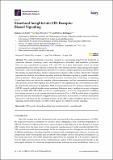Por favor, use este identificador para citar o enlazar a este item:
http://hdl.handle.net/10261/180725COMPARTIR / EXPORTAR:
 SHARE SHARE
 CORE
BASE CORE
BASE
|
|
| Visualizar otros formatos: MARC | Dublin Core | RDF | ORE | MODS | METS | DIDL | DATACITE | |

| Título: | Structural Insights into CB1 Receptor Biased Signaling |
Autor: | Al-Zoubi, Rufaida; Morales, Paula CSIC ORCID; Reggio, Patricia H. | Palabras clave: | CB1 receptors Biased signaling Functional selectivity Cannabinoids |
Fecha de publicación: | 13-abr-2019 | Editor: | Multidisciplinary Digital Publishing Institute | Citación: | International Journal of Molecular Sciences 20(8): 1837 (2019) | Resumen: | The endocannabinoid system has emerged as a promising target for the treatment of numerous diseases, including cancer, neurodegenerative disorders, and metabolic syndromes. Thus far, two cannabinoid receptors, CB1 and CB2, have been discovered, which are found predominantly in the central nervous system (CB1) or the immune system (CB2), among other organs and tissues. CB1 receptor ligands have been shown to induce a complex pattern of intracellular effects. The binding of a ligand induces distinct conformational changes in the receptor, which will eventually translate into distinct intracellular signaling pathways through coupling to specific intracellular effector proteins. These proteins can mediate receptor desensitization, trafficking, or signaling. Ligand specificity and selectivity, complex cellular components, and the concomitant expression of other proteins (which either regulate the CB1 receptor or are regulated by the CB1 receptor) will affect the therapeutic outcome of its targeting. With an increased interest in G protein-coupled receptors (GPCR) research, in-depth studies using mutations, biological assays, and spectroscopic techniques (such as NMR, EPR, MS, FRET, and X-ray crystallography), as well as computational modelling, have begun to reveal a set of concerted structural features in Class A GPCRs which relate to signaling pathways and the mechanisms of ligand-induced activation, deactivation, or activity modulation. This review will focus on the structural features of the CB1 receptor, mutations known to bias its signaling, and reported studies of CB1 receptor ligands to control its specific signaling. | Versión del editor: | http://dx.doi.org/10.3390/ijms20081837 | URI: | http://hdl.handle.net/10261/180725 | DOI: | 10.3390/ijms20081837 | ISSN: | 1661-6596 | E-ISSN: | 1422-0067 |
| Aparece en las colecciones: | (IQF) Artículos |
Ficheros en este ítem:
| Fichero | Descripción | Tamaño | Formato | |
|---|---|---|---|---|
| ijms-20-01837-v2.pdf | 2,81 MB | Adobe PDF |  Visualizar/Abrir | |
| 1_SupplementaryMaterial1_Figures_.docx | 2,95 MB | Microsoft Word XML | Visualizar/Abrir | |
| 2_SupplementaryMaterial2_cb1-sequence-alignment.xlsx | 94,09 kB | Microsoft Excel XML | Visualizar/Abrir |
CORE Recommender
PubMed Central
Citations
30
checked on 21-abr-2024
SCOPUSTM
Citations
55
checked on 19-abr-2024
WEB OF SCIENCETM
Citations
45
checked on 24-feb-2024
Page view(s)
198
checked on 22-abr-2024
Download(s)
322
checked on 22-abr-2024

